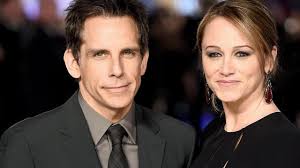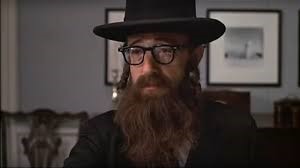Ben Stiller and “Meet the Parents”
 Life does not seem good for poor Harvey Weinstein, as it is now reported that his once high-flying production company will likely file for bankruptcy after his sexual harassment scandal has clearly metastasized. As reported at the end of February, “Harvey Weinstein’s film and TV production company is to file for bankruptcy after the sexual harassment scandal that has engulfed the beleaguered firm scuppered a last-ditch $500m deal to save the business.”
Life does not seem good for poor Harvey Weinstein, as it is now reported that his once high-flying production company will likely file for bankruptcy after his sexual harassment scandal has clearly metastasized. As reported at the end of February, “Harvey Weinstein’s film and TV production company is to file for bankruptcy after the sexual harassment scandal that has engulfed the beleaguered firm scuppered a last-ditch $500m deal to save the business.”
I wrote about the Jewish-gentile undercurrent of this scandal in “Harvey Weinstein: On Jews and the Shiksa.” On the heels of this came my unpacking of Dustin Hoffmann’s numerous shiksa films, particularly The Graduate. Since so many Jewish men crave “the golden shiksa,” or blonde Gentile woman, and given that Jews most certainly do control Hollywood, it follows that the theme of many movies feature Jewish men chasing Christian women. Just think of When Harry Met Sally, a 1989 American romantic comedy film written by Nora Ephron, whose friend Richard Cohen said of her, “She was very Jewish, culturally and emotionally. She identified fully as a Jewish woman.” Directed by Rob Reiner, who played the “revolutionary Jew” son-in-law “Meatball” on “All in the Family,” When Harry Met Sally stars the very Jewish Billy Crystal as Harry, the love interest of the very goy shiksa Sally, played by Meg Ryan.
As we shall see, one of the more interesting cases of actors with “shiksa lust” comes in the form of Ben Stiller, one of today’s Hollywood mega-stars. Stiller achieved acclaim for his 1998 appearance in There’s Something About Mary, an off-beat comedy about love denied. Paired against rival Pat Healy (Matt Dillon), Stiller’s Ted Stroehmann fights for the affection of old high school flame Mary Jenson (blonde, blue-eyed Cameron Diaz). While Stiller does not play an openly Jewish character in this film, his shtick seems to fall into that mold, particularly when he banters with his best friend and confidante, Dom. Son of comic actors Jerry Stiller and Anne Meara, Ben Stiller adopts in this movie a kind of gentle schlemiel identity that keeps the humor moving. Since there are no overtly Jewish themes in this movie, however, we might label this an “incipient Jewish character” and his desire for blonde Mary “incipient shiksa craving.” Any doubts, however, are removed in a pair of movies he made two years later, the first of which is the subject of today’s review.
Meet the Parents is a story about a Jewish boyfriend who is finally going to meet the wealthy parents of his shiksa girlfriend, Pam. The father is famously played by Robert De Niro as a retired CIA agent. The movie opens with a love scene as Stiller muddles through his attempt at proposing to Pam. From the beginning, Stiller is scripted as a likable loser. Appearing to be that stock Jewish character “my son the doctor,” a mensch, he is in fact only a male nurse, a career choice the movie belittles. His name in this movie also emphasizes this loser quality: Gaylord “Greg” Focker. Naturally, the play on his family name accounts for a dozen or more juvenile laughs throughout the movie.
Astute readers may at this point question my claim that Ben Stiller is even a Jewish actor, since his mother Anne Meara was Irish Catholic, though she converted to Judaism when she married Jerry Stiller in 1955. Jerry Stiller, however, is not just Jewish, he is flamboyantly Jewish, and this contrast gave rise to the dramatic tension used by the couple during much of their comedy team career.
 As a married couple appearing as such, Stiller and Meara were guests on “The Ed Sullivan Show” a total of thirty-six times, appeared frequently on “The Tonight Show Starring Johnny Carson,” and released a number of LPs featuring their comic routines. In the 1960s, Stiller and Meara were well-known characters in American comedy. Thus, they were an instance of the shiksa phenomenon right in plain sight, showing the American public what many Jewish men wanted. It is fitting, then, that this union produced son Ben Stiller (1965) who has gone on to adopt a Jewish identity in his hit films— productions that often feature the love interests of a Jewish man and gentile woman.
As a married couple appearing as such, Stiller and Meara were guests on “The Ed Sullivan Show” a total of thirty-six times, appeared frequently on “The Tonight Show Starring Johnny Carson,” and released a number of LPs featuring their comic routines. In the 1960s, Stiller and Meara were well-known characters in American comedy. Thus, they were an instance of the shiksa phenomenon right in plain sight, showing the American public what many Jewish men wanted. It is fitting, then, that this union produced son Ben Stiller (1965) who has gone on to adopt a Jewish identity in his hit films— productions that often feature the love interests of a Jewish man and gentile woman.
Ben Stiller is a diminutive man, standing 5’7”. Slightly built and sporting dark hair, Stiller comes across as more Jewish than Irish, though his light-colored eyes and facial structure do exhibit traits he no doubt inherited from his mother. With an inner energy that he restrains well, Stiller consistently creates a plausibly Jewish character—a choice he was wise to make since it has been very successful at the box office.
One more factor about Stiller’s life has to do with his choice of a mate and mother of his two children: Christine Taylor. Clearly, she is a “golden shiksa” if ever there was one. (After seventeen years of marriage, they separated last year.)

Now that we have set the stage for an examination of Meet the Parents (script by Jim Herzfeld), we can better understand the inner dynamics of the film, where Jewish elements are hardly limited to desire for the non-Jewish woman. As noted, Stiller’s Jewish character, Greg, is a Woody Allen-esque schlemiel (though far more attractive). Having decided to propose to his girlfriend Pam, Greg sets out to meet her parents. Comfortably situated in a wealthy Long Island suburb, Pam’s parents and their neighbors are of the better WASPy sort, and from the initial introduction, father Jack never warms to his daughter’s boyfriend. In fact, when the young couple first arrives by car, Jack doesn’t even acknowledge Greg’s presence, instead lapsing into a childish skit Pam used to love while growing up, setting up the central tension of the comedy: outsider intrudes upon a foreign tribe and all kinds of things go wrong. In other words, Meet the Parents is a fitting parable of Jews among the goyim.
We see this early on when they sit down for dinner. Because of Jack’s formality and seriousness, the atmosphere is unwelcoming, and Greg is clearly uncomfortable. Though non-Jewish director Jay Roach does not use camera tricks to show Greg as a Jewish boy from the shtetl, seasoned film buffs will immediately recall the hilarious scene in Woody Allen’s Annie Hall in which Allen’s character Alvy Singer sits down to dinner with his shiksa girlfriend’s family and feels every bit the coarse Ostjude. Enduring the withering stare of the non-Jewish grandmother throughout dinner, Singer practically melts in his seat, and later his girlfriend says, “You’re what Grammy Hall would call ‘a real Jew’.”

How Allen’s character Alvy “Max” Singer imagines himself in Annie Hall
Greg is almost as uncomfortable as he sits among the gentiles—”a Jew in a nest of WASPs,” in Los Angeles film critic Kenneth Turan’s words—and is asked to say grace. Pam protests, however: “Dad, Greg’s Jewish.” Thus, early in the film his identity is firmly established, a critical factor since the inner grammar of the film is the Jewish-gentile Kulturkampf. Though Greg is the butt of jokes and is routinely humiliated in the film, there is also covert hostility directed at the culture of these non-Jews, particularly Christianity. For instance, Pam’s compulsive father Jack forces his cat to use a human toilet to do its business; any hint of cat litter odor would be unacceptable. This sets up a scene where the family is again at the dinner table, and Greg pops open a thirteen-dollar bottle of champagne, the cork hitting the urn on the mantel holding Jack’s mother’s ashes. The urn totters and falls, shattering on the floor, at which point the family cat urinates in the ashes. This conflation of bodily elimination and symbols of gentile culture increases as the movie progresses.
To unpack this, we must retreat to a parallel story about the (Christian) wedding of Pam’s younger sister. Because family friends are also taking part, there is a breakfast scene in which virile non-Jewish men discuss their jobs as doctors and such, allowing another joke at the expense of Greg Focker, RN. Venting his feelings about the tall, thin doctor, Greg mutters to himself that this doctor is another “Torquemada.” This telling reference to the famous Grand Inquisitor alludes to a worldview of persecution of Jews.
Nearly an hour into the comedy comes the starkest Jewish-gentile contrast. In fact, it is so blatant that I wonder if this was really meant as a comedy at all. Greg, who is small in stature and insecure about his relationship with Pam, is handed his worst nightmare: he must meet Pam’s former fiancé. Arriving by car, Greg and Pam’s family drive up to an enormous mansion owned by Kevin, the old boyfriend. Obviously enamored of Kevin’s talents, Pam’s father Jack joyfully embraces Kevin at the doorstep. Wondering why such a bond exists, Greg is told by Pam that Kevin and her father became close at one of those typically WASP places—a lacrosse camp.
Surely Kevin’s physical features are no accident in this film. Tall and handsome, he exhibits those most Aryan of features—strong nose and chin, long, flowing blond hair, and sparkling blue eyes. Consistently, these features are contrasted with Greg’s short stature and dark features. This is even emphasized by their clothing: Greg wears dark, heavy clothing, while Kevin has on a brilliant white sweater.
Once inside, the humiliations continue. Kevin still keeps pictures of himself and Pam, and Greg agonizingly looks at each of them—Kevin and Pam skiing together, Kevin and Pam horseback riding together, Kevin and Pam skydiving together. Greg’s insecurity grows. Once in the kitchen, Kevin and Greg, as rivals, feel out each other’s position, with Greg clearly losing. Kevin, it seems, has made millions in the stock market, all without trying and without really craving money. Greg, on the other hand, has no portfolio and merely rents his apartment rather than owning his own home.
Because Kevin is financially secure, he can devote himself to his hobbies, and it is here that the movie becomes explicit. Showing his guests his extensive carpentry shop, Kevin goes on to display some of his highly adept work. Then, when Greg asks him why he chose “carpentering,” Kevin gets even more serious and replies, “Because Jesus was a carpenter.” Kevin has been established not only as a Christ figure, but as a rival to the Jewish Greg. Minutes later, Kevin unveils his masterpiece: a wedding canopy hand-carved from a single piece of wood that will serve as Pam’s sister’s wedding site in the yard. Though it would seem that a wooden canopy without any religious symbolism would serve just as well, in this movie it is a specifically Christian prop, carved by that Christ-loving figure, Kevin. Soon the audience sees what role it plays.
In the meantime, guests continue to arrive for the wedding rehearsal; they are all fair-skinned, fair-haired, outdoor WASP types. Soon, they drum up a game of volleyball in Greg’s spacious indoor pool, the gentile men aggressively going for the win while Greg, the male nurse, predictably performs poorly, earning the noisy censure of the males who surround him. Pam, in the meantime, has symbolically paired up with her former boyfriend who, in the heat of the competition, cannot even remember Greg’s name.
Thus provoked, Greg resolves to show his manliness. Since this is ostensibly a comedy of manners, however, when Greg succeeds, he loses. Jumping high above the net for a spike, Greg in slow motion slams the ball into the face of the soon-to-be bride, breaking her nose and giving her a black eye. The others all berate Greg and circle around the bride on one side of the net while Greg is ostracized literally and figuratively to the other side of the net. This filmic portrayal of gentiles on one side and the lone Jew on the other recurs throughout the movie.
Next comes an adolescent feces scene. Despite being told not to flush the guest room toilet, Greg forgets and sets off a disaster: the cesspool overflows into the yard where the wedding rehearsal is to be held, covering it with slimy brown human waste. Then, into this semi-liquid mess comes Kevin in a large flat-bed truck, delivering his wedding canopy. Though Jack and the others scream for him to stop, Kevin backs into the soggy yard and the wheels begin to sink. Not appreciating the situation at all, he then guns the engine, throwing feces in the faces of Jack and family.
Things can and do get worse. Chasing the wayward family cat onto the roof, Greg surreptitiously sneaks a forbidden smoke. Unfortunately, his cigarette tumbles into the leaf-filled eaves trough and ignites a fire. Attempting to put out the blaze, Greg inadvertently kicks the eaves trough away from the house, causing it to fall over a live electric cable, which snaps and falls onto the malodorous ground. Then, in a scene of some significance, the sparking cable snakes over to the wedding canopy and ignites it. Greg, the Jew, has burned the Christian artifact to black charcoal, a scene in which the symbolism is manifest.
It is almost as though John Murray Cuddihy’s observation in The Ordeal of Civility about what Freud wrote has been enacted in this scene: “to my youthful mind Hannibal and Rome symbolized the conflict between the tenacity of Jewry and the organization of the Catholic church.” The parallel is intriguing: is Greg carrying out on screen a version of a fantasy Freud himself had? Cuddihy’s remarks bring us to the brink of a match: “Clearly, Oedipus does what the young Freud wished his father had done. It is a forbidden wish, one that Freud cannot admit into consciousness except in ‘sublimated’ form. He will unmask these goyim. Like Hamilcar’s son Hannibal, he will storm Rome seeking vengeance.”
Lest there be any doubt about this juxtaposition of Christianity and excrement, the next scene is of a Christian minister rehearsing marital vows in the yard, a scene that immediately segues to a group of workers who have inserted a large hose into the open cesspool to suck out its fetid contents. The sentiments that inform these multiple Christianity/shit scenes implicitly imply that “Christianity is shit.”
(OK, can readers recall an article I wrote, originally posted on Christmas Day 2008, about South Park’s Christmas special, “Mr. Hankey the Christmas Poo”? Mr. Hankey was introduced in a 1997 episode that showed the young Jewish boy Kyle brushing his teeth. Mr. Hankey, wearing a Santa hat, jumps out of the toilet bowl and sings a song about Santa and Christmas. The starkest comment in the scene comes when this animated feces writes “Noel” in excrement on the mirror.

Eventually, Greg and Jack have their showdown and both give some ground yet refuse to budge on other issues. A full reconciliation is eventually made, however, and Greg is welcomed into the “circle of trust” that exists in Pam’s family. His proposal is accepted and they will be happily married after all. Curiously, though, an intriguing scene is tacked onto the ending. After all has been settled, Jack breaks the circle of trust and checks a hidden surveillance tape of his soon-to-be son-in-law. Greg’s soliloquy here opens up serious questions about the degree of reconciliation gained between the Jew as outsider. Quite aggressively, Greg speaks into the hidden camera and berates Jack for his absurd values, unmasking his supposedly superior status. Greg has the final words, words that securely put Jack in his place. This is precisely what Cuddihy means when he discusses, “the unconscious desire of Jews, as social pariahs, to unmask the respectability of the European society which closed them out.”
Remember, Meet the Parents was released in 2000, yet for a few years afterward, as I wrote about the Jewish elements in it and talked to professors and others about it, not one person agreed there was any such theme embedded in the film. This drove me to distraction. Well, come 2004, the world was treated to the sequel, called Meet the Fockers. And who were “the Fockers”? None other than Barbara Streisand and Dustin Hoffman starring as Gaylord Focker’s parents! The entire comedy was framed around the differing sensibilities of Jews and gentiles, though this time explicitly.
At this point, readers might think that I view Ben Stiller as an actor caught up in Jewish attack on Whites and Christianity. In fact, it is more complicated than that, because in 2000, the same year Meet the Parents came out, Stiller starred in another “get the shiksa” film, but one with remarkable subtlety and compassion. That will be my next review.






Comments are closed.